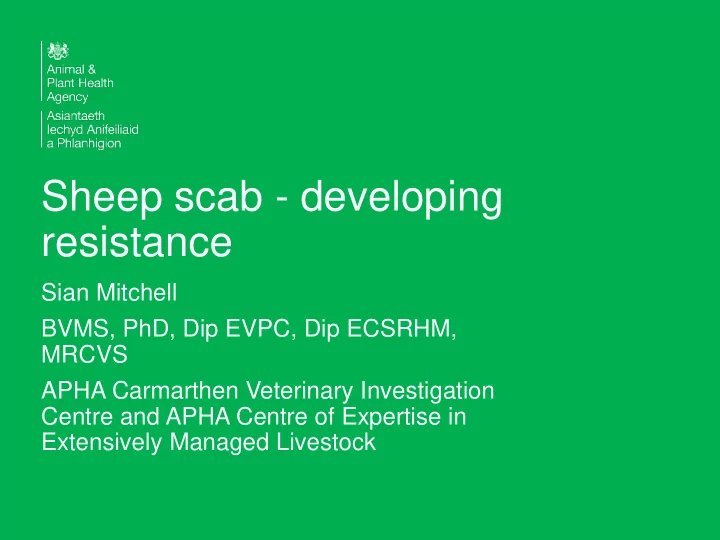

Sheep scab - developing resistance Sian Mitchell BVMS, PhD, Dip EVPC, Dip ECSRHM, MRCVS APHA Carmarthen Veterinary Investigation Centre and APHA Centre of Expertise in Extensively Managed Livestock
Sheep scab- developing resistance • Clinical signs of sheep scab • Treatments available • Clinical case details winter 2016/17 • The in-vitro test developed at University of Bristol • Further work
Clinical signs- pruritic (itchy) sheep
A typical case of sheep scab
Skin lesions and the mites
Sheep disease surveillance dashboard https://public.tableau.com/profile/siu.apha#!/vizhome/SheepDashboard_/SheepDashboard
Treatments Only two types of treatment • Injectable macrocyclic lactones (MLs) - ivermectin, doramectin, moxidectin • Organophosphate (OP) dips AND all of the group have to be treated
Injectable MLs • Do not kill all mite stages immediately • Site, method and ease of injection varies • Varying persistency, so vary in need to move post treatment and time allowed before mixing with untreated sheep • All are anthelmintics – use has implications on anthelmintic resistance development
OP dips • Needs to be done correctly – immersion times, replenishment Advantages • Wash effect • Broad spectrum ectoparasiticide (i.e. lice and mites) Disadvantages • Dip disposal • Not licensed for use in showers • Human health concerns
Clinical case 1 Large sheep flock in Ceredigion October 2016 -Treatment with moxidectin 2% all ewes in different groups November 2016. Number showing pruritis, one group 400 particularly badly affected. Repeated moxidectin 2%, no improvement Mite samples to University of Bristol for in-vitro test development OP dip - instant improvement
Clinical case 2 Sheep flock in Carmarthenshire End October 2016 -Treatment of all animals with doramectin. Ewe lambs sent away ‘on tack’. No contact with other sheep, double fenced from neighbours December 2016. Number showing pruritis, (particularly store lambs). PVS detected live Psoroptes ovis mites. Two injections of ivermectin given (meat withdrawal). January 2017 Pruritis in number of animals, samples to APHA. Live mites in samples from two separate groups Mite samples to University of Bristol OP dip - all improved
Other cases, no in-vitro tests carried out Sheep flock in mid Wales. Doramectin given twice to whole flock. Clinical signs persisted in animals in various groups. Samples to APHA. Live mites in all groups. OP dipping advised Sheep flock Cheshire. Treated twice with doramectin October and November 2016. December, live mites seen in samples to veterinary practice. Weighed and treated moxidectin 2%. Little improvement. APHA samples, live mites seen. Dipped- all improved Small sheep flock Shropshire. October 2016 all flock given doramectin , some clinical improvement. December 2016 Moxidectin 2% given, slight improvement. Jan 2017 doramectin used, no improvement . APHA samples Feb 2017 live mites seen- OP dip advised
Summary of cases • Use of multiple ML treatments in each flock • Often no diagnosis before first treatments • Some cases showed slight clinical improvement post treatment, others no cessation of clinical signs • Appeared that treatments had been done correctly
In-vitro test at University of Bristol • Bioassay based on published method for resistance in Sarcoptes scabei mites ( Brimer et al, Vet Parasitol (1995) 59, 249-255 ) • Agar plates containing various concentrations of moxidectin and negative control plates. Mite mortality measured over time • Psoroptes ovis mites from Moredun Research Institute (fully susceptible) used as controls • Mortality from four field samples (two from Wales and two from Herefordshire) differed significantly from controls • First demonstration of resistance in Psoroptes ovis mites to MLs in UK • Likely cross resistance to other ML treatments • Published Veterinary Record Jan 2018, 182 (4) 106 • Anecdotal evidence of other cases during winter 2016/17 and 17/18
In-vitro bioassay 500 ng/ml moxidectin and ethanol control Moredun Research Institute mites- controls 100 Positive control (MRI+) – 500 ng/ml moxidectin 80 Mortality (%) 60 Negative control (MRI-) ethanol only 40 20 0 0 24 72 96 120 Time (h)
In-vitro bioassay results - 3 farms 500 ng/ml moxidectin and controls 100 Positive control (MRI+) 500 ng/ml 80 Farm outbreaks West Wales & Welsh border) Mortality (%) 60 (500 ng/ml moxidectin) Negative control (MRI-) 40 ethanol only 20 0 0 24 72 96 120 Time (h)
In-vitro bioassay 1000 and 2000ng/ml moxidectin and ethanol control Moredun Research Institute control mites Positive controls (MRI+) 100 ● 1000 ng/ml moxidectin ♦ 2000 ng/ml moxidectin 80 Mortality (%) 60 Negative control (MRI-) ethanol only 40 20 0 0 24 72 96 120 Time (h)
In-vitro bioassay results - one farm 1000 and 2000 ng/ml moxidectin and controls Positive controls (MRI+) 100 ● 1000 ng/ml moxidectin ♦ 2000 ng/ml moxidectin 80 Mortality (%) 60 Negative control (MRI-) ethanol only 40 Farm outbreak (Herefordshire) ● 1000 ng/ml moxidectin 20 ♦ 2000 ng/ml moxidectin 0 0 24 72 96 120 Time (h)
Further work at University of Bristol 2017/18 • Testing more field samples • Extending in vitro tests to using ivermectin and doramectin
Summary • Diagnose, treat correctly and investigate poor clinical efficacy • Free ectoparasite examination in Wales (ended 31 st March 2018) • Sheep scab is a severe welfare issue and causes production loss • ML resistance will make sheep scab more difficult to control
Acknowledgements • Practising vets and farmers for sample submission • Prof Richard Wall, Emma Doherty and Charlotte Sturgess-Osborne, University of Bristol • Dr Stewart Burgess, Moredun Research Institute • University of Bristol work funded by Zoetis • APHA scanning surveillance funded by Defra, Welsh and Scottish governments
Recommend
More recommend